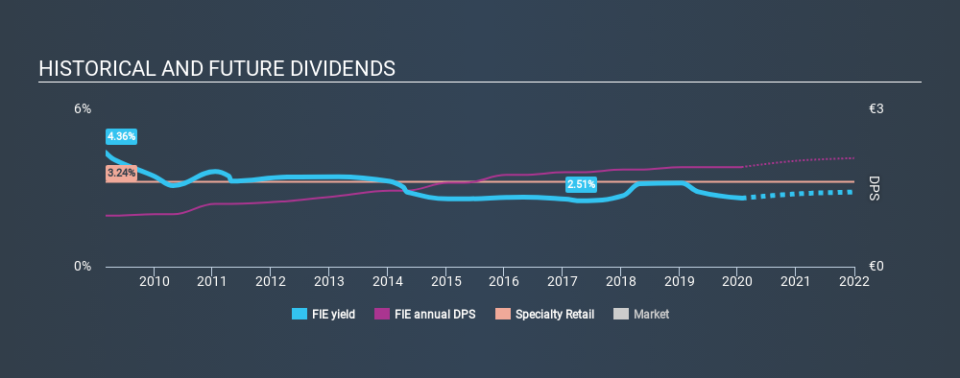Should Fielmann Aktiengesellschaft (ETR:FIE) Be Part Of Your Dividend Portfolio?

Dividend paying stocks like Fielmann Aktiengesellschaft (ETR:FIE) tend to be popular with investors, and for good reason - some research suggests a significant amount of all stock market returns come from reinvested dividends. Unfortunately, it's common for investors to be enticed in by the seemingly attractive yield, and lose money when the company has to cut its dividend payments.
A slim 2.6% yield is hard to get excited about, but the long payment history is respectable. At the right price, or with strong growth opportunities, Fielmann could have potential. Some simple analysis can reduce the risk of holding Fielmann for its dividend, and we'll focus on the most important aspects below.
Explore this interactive chart for our latest analysis on Fielmann!
Payout ratios
Dividends are usually paid out of company earnings. If a company is paying more than it earns, then the dividend might become unsustainable - hardly an ideal situation. Comparing dividend payments to a company's net profit after tax is a simple way of reality-checking whether a dividend is sustainable. Fielmann paid out 91% of its profit as dividends, over the trailing twelve month period. With a payout ratio this high, we'd say its dividend is not well covered by earnings. This may be fine if earnings are growing, but it might not take much of a downturn for the dividend to come under pressure.
We also measure dividends paid against a company's levered free cash flow, to see if enough cash was generated to cover the dividend. The company paid out 75% of its free cash flow, which is not bad per se, but does start to limit the amount of cash Fielmann has available to meet other needs. While the dividend was not well covered by profits, at least they were covered by free cash flow. Still, if the company continues paying out such a high percentage of its profits, the dividend could be at risk if business turns sour.
With a strong net cash balance, Fielmann investors may not have much to worry about in the near term from a dividend perspective.
We update our data on Fielmann every 24 hours, so you can always get our latest analysis of its financial health, here.
Dividend Volatility
One of the major risks of relying on dividend income, is the potential for a company to struggle financially and cut its dividend. Not only is your income cut, but the value of your investment declines as well - nasty. Fielmann has been paying dividends for a long time, but for the purpose of this analysis, we only examine the past 10 years of payments. During this period the dividend has been stable, which could imply the business could have relatively consistent earnings power. During the past ten-year period, the first annual payment was €0.97 in 2010, compared to €1.90 last year. This works out to be a compound annual growth rate (CAGR) of approximately 6.9% a year over that time.
Companies like this, growing their dividend at a decent rate, can be very valuable over the long term, if the rate of growth can be maintained.
Dividend Growth Potential
While dividend payments have been relatively reliable, it would also be nice if earnings per share (EPS) were growing, as this is essential to maintaining the dividend's purchasing power over the long term. Fielmann has grown its earnings per share at 4.8% per annum over the past five years. This level of earnings growth is low, and the company is paying out 91% of its profit. Limited recent earnings growth and a high payout ratio makes it hard for us to envision strong future dividend growth, unless the company should have substantial pricing power or some form of competitive advantage.
Conclusion
Dividend investors should always want to know if a) a company's dividends are affordable, b) if there is a track record of consistent payments, and c) if the dividend is capable of growing. We're a bit uncomfortable with its high payout ratio, although at least the dividend was covered by free cash flow. Earnings per share growth has been slow, but we respect a company that maintains a relatively stable dividend. Ultimately, Fielmann comes up short on our dividend analysis. It's not that we think it is a bad company - just that there are likely more appealing dividend prospects out there on this analysis.
Earnings growth generally bodes well for the future value of company dividend payments. See if the 9 Fielmann analysts we track are forecasting continued growth with our free report on analyst estimates for the company.
If you are a dividend investor, you might also want to look at our curated list of dividend stocks yielding above 3%.
If you spot an error that warrants correction, please contact the editor at editorial-team@simplywallst.com. This article by Simply Wall St is general in nature. It does not constitute a recommendation to buy or sell any stock, and does not take account of your objectives, or your financial situation. Simply Wall St has no position in the stocks mentioned.
We aim to bring you long-term focused research analysis driven by fundamental data. Note that our analysis may not factor in the latest price-sensitive company announcements or qualitative material. Thank you for reading.

